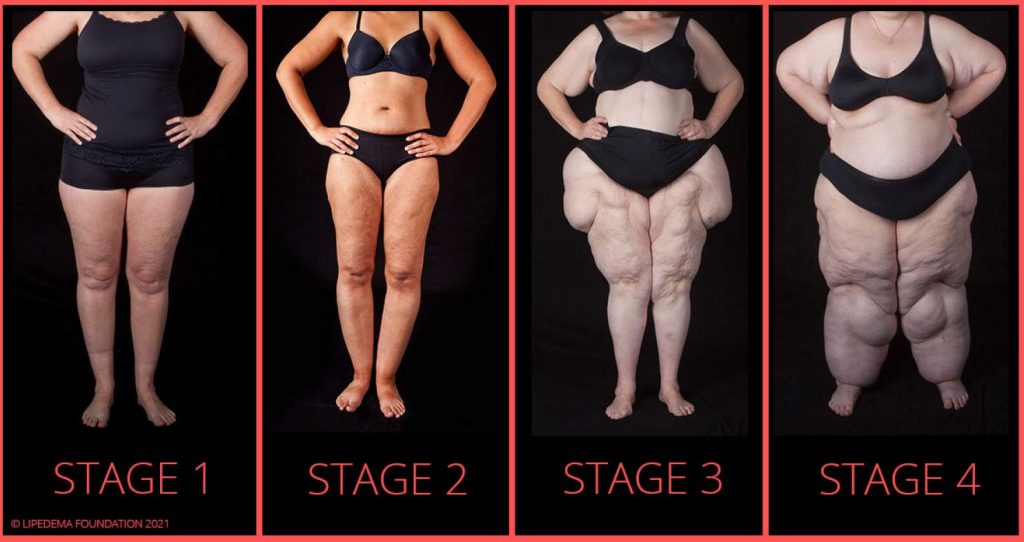Table of Contents
Lipedema is a condition that causes abnormal buildup of fat in the legs, thighs, and sometimes arms. 11% of adult women are almost exclusively affected by lipedema. Despite often being mistaken for obesity, lipedema is a distinct medical disorder. Learning about its symptoms, causes, diagnosis, and treatment options can help those living with lipedema properly manage this progressive condition.
What is Lipedema?

Lipedema causes significant swelling and enlargement specifically in the legs due to localized fat accumulation. The fat buildup associated with lipedema occurs only from the hips down to the ankles symmetrically in both legs. Arms may also be affected in some cases. Lipedema fat is different from typical body fat and does not respond to diet and exercise.
Common Signs and Symptoms of Lipedema
- Disproportionately large legs compared to the torso, hips, and arms
- Swelling that worsens throughout the day
- Fatty tissue growths or nodules on the legs
- Chronic leg pain
- Legs feel heavy and experience quicker fatigue
- Tenderness around the legs from fluid retention in the tissue
- Bruising easily on the legs, even with minor bumps or knocks
What Causes Lipedema?
The exact cause of lipedema is not fully understood. Research suggests that it likely involves a combination of hormones, genetic factors, and lifestyle elements including:
- Estrogen dominance: Estrogen triggers fat growth and women tend to develop lipedema around puberty, pregnancy, and menopause when estrogen levels fluctuate.
- Genetics: Lipedema appears to run in families, indicating a genetic component. Variations in genes involved in metabolizing fat may contribute.
- Inflammation: Chronic inflammation appears to stimulate the abnormal fat accumulation in lipedema.
- Stress: Emotional and psychological stress can worsen lipedema progression. The stress hormone cortisol may influence fat cells.
- Injury: Physical trauma or surgery to the affected area is thought to potentially trigger lipedema development in some cases.
Who Gets Lipedema? Understanding the Demographics
Lipedema overwhelmingly impacts women close to puberty and childbearing age, when hormone changes occur. Up to 11% of adult women may have some degree of lipedema. The following demographic patterns are associated with lipedema:
- Gender: Over 90% of cases occur in women. It rarely affects men.
- Onset: It often emerges during puberty, pregnancy, menopause, or times of hormonal change.
- Weight: It occurs in women of all sizes, from average weight to obese.
- Heredity: Around 40% of patients have a mother or sister with lipedema, indicating a genetic link.
Lipedema vs. Lymphedema vs. Obesity
Lipedema is often confused with similar conditions lymphedema and obesity:
- Lymphedema also involves fluid buildup and swelling but affects the full arm or leg. Lipedema swelling stops at the ankles and wrists.
- Obesity is a full-body condition involving fat cell enlargement. Lipedema only occurs from the hips to ankles symmetrically in both legs and sometimes arms.
Stages of Lipedema Progression
Lipedema advances through three key stages:
Stage 1
There is an even but enlarged layer of fat just under the skin. The skin has a smooth, matte finish but may show minor indentations when pressed due to fat growths. Bruising is common.
Stage 2
Skin takes on a nodular appearance with fatty bulges. The tissue feels like small beads. Larger, protruding nodules or masses form near joints. Swelling increases.
Stage 3
The skin has a cobblestone texture with large, protruding masses and folds of fat. Fatty tissue accumulates around the knees and ankles. Mobility is impacted.
Read also: How to Stop Being Weird and Creepy
Getting a Lipedema Diagnosis
Since lipedema is often unknown by doctors, patients usually discover they have it after years of being mistaken for obesity. A lipedema diagnosis involves:
- Consulting a doctor familiar with lipedema. Often lymphologists or plastic surgeons recognize it.
- Providing full medical history and description of symptoms. Keeping a symptom log for several weeks can help.
- Having an exam to confirm disproportionate fat only in the legs, with sparing of the feet and hands.
- Getting tests done to rule out other conditions like lymphedema or lipo lymphedema. These may include MRI, CT, ultrasound, x-ray, and blood tests.
Lipedema Treatment
Effective lipedema treatment requires a multifaceted approach including:
1. Lymphatic Drainage Therapy
Special massage techniques help drain fluid buildup from fat tissue and improve circulation. This may reduce swelling and tenderness short term.
2. Compression Garments
Wearing medical-grade compression stockings and leggings can help minimize swelling during the day. Garments should fully cover affected areas.
3. Aerobic Exercise
Low-impact aerobic exercises like swimming, water aerobics, and cycling can improve lymphatic and vascular function. It is vital to avoid injury and select exercises that do not put pressure on limbs.
4. Liposuction
Removing excess fat through liposuction (usually tumescent) is often necessary to stop lipedema progression. It should be done by a qualified surgeon familiar with lipedema.
5. Good Nutrition
Eating a healthy diet focused on anti-inflammatory foods can help reduce inflammation and fluid retention. Nutritional counseling may be beneficial.
6. Stress Management
Relaxation techniques, sufficient sleep, and counseling help minimize stress levels. This aids overall lipedema management.
7. Targeted Medications
Diuretics and other medications that reduce swelling may provide some relief from symptoms.
Final Words
Dealing with lipedema can be challenging both physically and emotionally. The condition is often misunderstood, even by doctors. Being your own best advocate through education, finding knowledgeable specialists, and diligently following treatment protocols helps patients properly manage lipedema. With the right care, people can go on to live happy, active lives with this condition.
People also ask
What is lipedema caused by?
Lipedema’s exact cause is unclear, but hormonal and genetic factors are considered contributors. It primarily affects women and involves an abnormal accumulation of fat, causing disproportionate swelling in the limbs.
How can I tell if I have lipedema?
Common signs include symmetrical fat deposits in the legs, often resistant to diet and exercise. Tender areas, easy bruising, and a “bracelet” effect at the ankles may indicate lipedema.
Can lipedema fat go away?
Lipedema fat typically doesn’t respond well to traditional weight loss methods. While some management is possible through lifestyle changes, complete elimination is challenging without specific treatments.
Do I have lipedema or just fat legs?
Consulting a healthcare professional is crucial for an accurate diagnosis. Lipedema involves specific characteristics beyond regular fat accumulation, and a medical evaluation is essential.




